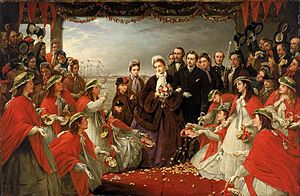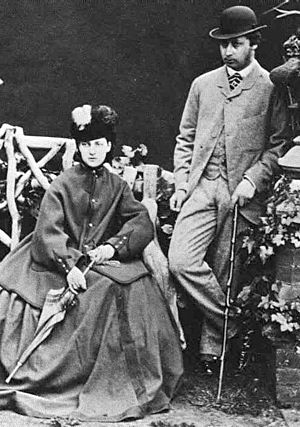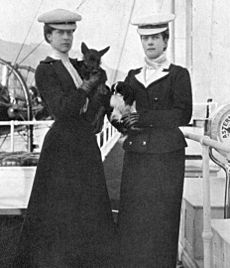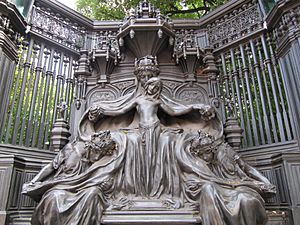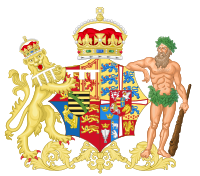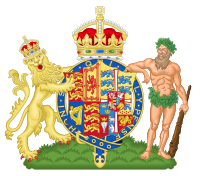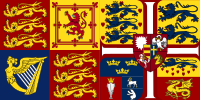Alexandra of Denmark facts for kids
Quick facts for kids Alexandra of Denmark |
|||||
|---|---|---|---|---|---|

Photograph by W. & D. Downey, c. 1889
|
|||||
| Queen consort of the United Kingdom and the British Dominions, Empress consort of India |
|||||
| Tenure | 22 January 1901 – 6 May 1910 | ||||
| Coronation | 9 August 1902 | ||||
| Imperial Durbar | 1 January 1903 | ||||
| Born | Princess Alexandra of Schleswig-Holstein-Sonderburg-Glücksburg 1 December 1844 Yellow Palace, Copenhagen, Denmark |
||||
| Died | 20 November 1925 (aged 80) Sandringham House, Norfolk, England |
||||
| Burial | 28 November 1925 St George's Chapel, Windsor Castle |
||||
| Spouse | |||||
| Issue | |||||
|
|||||
| House | Glücksburg | ||||
| Father | Christian IX of Denmark | ||||
| Mother | Louise of Hesse-Kassel | ||||
| Signature | |||||
Alexandra of Denmark (born December 1, 1844 – died November 20, 1925) was the Queen of the United Kingdom and Empress of India. She was married to King Edward VII and became Queen in 1901.
The world's largest butterfly, the Queen Alexandra's birdwing, was named in her honor.
Alexandra's family was not very well known until 1852. That year, her father, Prince Christian, was chosen to become the next king of Denmark. When she was sixteen, Alexandra was picked to be the future wife of Albert Edward, who was the son of Queen Victoria and the heir to the British throne. They married in 1863. In the same year, her father became King of Denmark, and her brother became king of Greece.
Alexandra was the Princess of Wales from 1863 to 1901, holding this title longer than anyone else. She was very popular, and many fashion-conscious women copied her style. She wasn't allowed much political power. However, she tried to influence British leaders and her husband's family to support Greek and Danish interests. Her public duties mostly involved helping with charity work.
When Queen Victoria died in 1901, Albert Edward became King Edward VII, and Alexandra became Queen. She was Queen until Edward died in 1910. Then, their son George V became king. Alexandra passed away in 1925 at the age of 80.
Contents
Early Life of Queen Alexandra
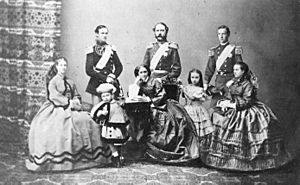
Princess Alexandra Caroline Marie Charlotte Louise Julia was born on December 1, 1844. Her family called her "Alix." She was born at the Yellow Palace, Copenhagen, a large house in Copenhagen, Denmark. Her father was Prince Christian of Schleswig-Holstein-Sonderburg-Glücksburg. Her mother was Princess Louise of Hesse-Kassel. Alexandra had five brothers and sisters: Frederick, George, Dagmar, Thyra, and Valdemar.
Her father's family was a distant part of the Danish royal family. Even though they were of royal blood, they did not have a lot of money. Her father's income from the army was about £800 a year. They lived in a house that they didn't have to pay rent for. Sometimes, the famous storyteller Hans Christian Andersen would visit and tell stories to the children before bed.
In 1848, the King of Denmark died without any children. This caused a problem about who would be the next king. In 1852, important European countries met in London to decide. They agreed that Prince Christian, Alexandra's father, would become the next King of Denmark.
After this, her family moved to a new home called Bernstorff Palace. Even though their status grew, their income did not increase much. Alexandra and her sister, Dagmar, shared a cold attic bedroom. They even made their own clothes and helped serve food at the table. Alexandra and Dagmar learned to swim from Nancy Edberg, a Swedish pioneer in women's swimming. Alexandra learned English from an English chaplain and was confirmed in Christiansborg Palace. She was a very religious person throughout her life.
Marriage to Prince Albert Edward
Queen Victoria and her husband, Prince Albert, were looking for a wife for their son, Albert Edward, the Prince of Wales. They asked their daughter, Crown Princess Victoria of Prussia, to help. Alexandra was not their first choice. This was because Denmark and Prussia were having disagreements over the Schleswig-Holstein Question, a dispute about some land. Also, most of the British royal family had German relatives. But in the end, they decided Alexandra was the best choice.
On September 24, 1861, Albert Edward met Alexandra in Germany. About a year later, on September 9, 1862, Albert Edward asked Alexandra to marry him. This happened at the Royal Castle of Laeken in Belgium.
A few months later, Alexandra traveled from Denmark to Britain on the royal yacht. She arrived in Gravesend on March 7, 1863. The famous composer Arthur Sullivan wrote music for her arrival. The Poet Laureate, Alfred, Lord Tennyson, wrote a special poem for her:
Sea King's daughter from over the sea,
Alexandra!
Saxon and Norman and Dane are we,
But all of us Danes in our welcome of thee,
Alexandra!
The wedding took place on March 10, 1863, at St George's Chapel, Windsor Castle. Many people criticized the choice of location. They felt it was too far from London for the public to see. Also, the chapel was small, so some expected guests were disappointed. The British court was still in mourning for Prince Albert, so ladies had to wear dull colors like grey or purple.
By the end of the next year, Alexandra's father had become King of Denmark. Her brother George had become King of Greece. Her sister Dagmar was engaged to the future Emperor of Russia. And Alexandra had given birth to her first child. Her father becoming king led to more conflict over Schleswig-Holstein. German forces invaded Denmark, and Denmark lost a large part of its land. This made Alexandra strongly dislike Germans, a feeling she kept for the rest of her life.
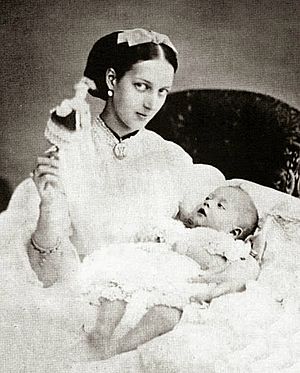
Alexandra's first child, Albert Victor, was born early in 1864. Alexandra loved her children very much. She was happiest when she could go to the nursery, put on an apron, wash her children, and see them asleep. Albert Edward and Alexandra had six children: Albert Victor, George, Louise, Victoria, Maud, and Alexander. All her children seemed to be born early. Some historians think Alexandra purposely told Queen Victoria later due dates. She did not want the Queen to be present at the births. When her third child was born in 1867, Alexandra became very ill with rheumatic fever. This illness nearly took her life and left her with a permanent limp.
In public, Alexandra was graceful and charming. In private, she was loving and cheerful. She enjoyed dancing and ice-skating. She was also a skilled horse rider and enjoyed driving carriages. She even enjoyed hunting, which Queen Victoria did not like. Even after her first child was born, she continued to socialize a lot. This caused some tension between her and the Queen. This was made worse by Alexandra's dislike of Germans and the Queen's preference for them.
Princess of Wales (1863–1901)
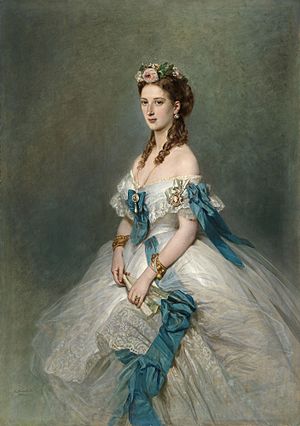
Albert Edward and Alexandra visited Ireland in April 1868. Alexandra was still recovering from her illness the year before and was pregnant with her fourth child. From 1868 to 1869, the royal couple went on a six-month tour. They visited Austria, Egypt, and Greece. She also visited her brother, George I of Greece. In Turkey, she was the first woman to have dinner with the Sultan.
The Prince and Princess of Wales preferred to live at Sandringham House. Their home in London was Marlborough House. Many historians agree that their marriage was happy in many ways. However, some say that Albert Edward did not give his wife enough attention. They suggest they grew apart until he became very ill with typhoid fever in 1871. This illness brought them closer again. Others disagree, pointing out Alexandra's frequent pregnancies and family letters that show no serious problems. Still, many people criticized the prince for not showing enough concern during Alexandra's serious illness. Throughout their marriage, Albert Edward spent time with other women. Alexandra knew about most of these relationships. She even allowed one of his friends, Alice Keppel, to visit him when he was dying. Alexandra herself remained loyal to her husband.
Alexandra's hearing became worse due to a condition called otosclerosis. This made her feel more isolated. She spent more time at home with her children and pets. Her sixth and last child was born in April 1871 but died the next day.
For eight months in 1875–76, the Prince of Wales toured India. Alexandra was sad that she was left behind. The prince had planned a trip for men only, focusing on hunting.
Alexandra spent the spring of 1877 in Greece. She was recovering from an illness and visiting her brother, King George. During the Russo-Turkish War, Alexandra clearly favored Russia. Her sister was married to the Russian heir. Alexandra pushed for changes to the border between Greece and Turkey to help the Greeks. For the next three years, Alexandra was mostly separated from her two sons. They were sent on a worldwide cruise as part of their naval training. She missed them terribly, as her letters show. In 1881, Alexandra and Albert Edward traveled to Saint Petersburg. They went after the assassination of Alexander II of Russia. They represented Britain and Alexandra comforted her sister, who had become the Empress of Russia.
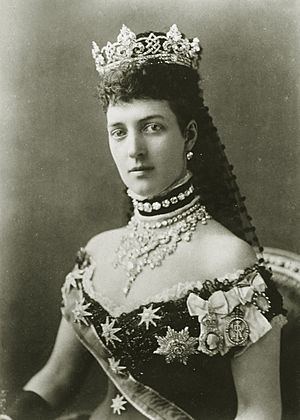
Alexandra took on many public duties. Queen Victoria said Alexandra helped "to spare me the strain and fatigue of functions." She opened events, attended concerts, and visited hospitals. She never complained and seemed to enjoy these duties. She was especially interested in the Royal London Hospital. She visited it often and even met Joseph Merrick, known as the "Elephant Man." Crowds usually cheered Alexandra enthusiastically. However, during a visit to Ireland in 1885, she faced some public anger. In the City of Cork, a place with strong Irish nationalist feelings, she and her husband were booed by a crowd. She smiled through it, and the British newspapers still reported it positively. During the same visit, she received a special degree from Trinity College Dublin.
The death of her oldest son, Prince Albert Victor, Duke of Clarence and Avondale, in 1892 was a terrible shock for Alexandra. She kept his room and belongings exactly as he had left them. She said, "I have buried my angel and with him my happiness." Letters between Alexandra and her children show they loved each other very much. In 1894, her brother-in-law, the Emperor of Russia, died. Her nephew Nicholas II of Russia became the new Emperor. Alexandra's widowed sister, the Dowager Empress of Russia, relied heavily on her for support. Alexandra stayed with her sister for two weeks until the burial. Alexandra and her husband stayed for the wedding of Nicholas to their niece, Princess Alix of Hesse.
Queen and Empress Consort (1901–1910)
When her mother-in-law, Queen Victoria, died in 1901, Alexandra became Queen and Empress. She was the wife of the new king, Edward VII. Just two months later, her son George and his wife Mary went on a long tour of the empire. They left their young children with Alexandra and Edward, who loved their grandchildren very much. When George returned, plans for Edward and Alexandra's coronation were ready. But just days before the coronation in June 1902, the King became very ill with appendicitis. Alexandra took his place at a military parade and attended the Royal Ascot races without him. She did this to prevent public worry. The coronation had to be postponed. Edward had an operation to remove his infected appendix. After he recovered, Alexandra and Edward were crowned together in August.
Even as Queen, Alexandra's duties did not change much. She kept many of the same staff. Her lady-in-waiting, Charlotte Knollys, served Alexandra loyally for many years. In 1903, Knollys woke up to find her bedroom full of smoke. She woke Alexandra and led her to safety.
Alexandra again looked after her grandchildren when George and Mary went on another tour. This time they went to British India in the winter of 1905–06. Her father, Christian IX of Denmark, died that January. To keep their family ties strong, Alexandra and her sister, the Dowager Empress of Russia, bought a villa north of Copenhagen in 1907. It was called Hvidøre, and they used it as a private retreat.
Alexandra was not allowed to see the King's secret papers. She was also left out of some of his trips abroad. This was to stop her from getting involved in diplomatic matters. She deeply distrusted Germans, especially her nephew, Emperor Wilhelm II. She always opposed anything that helped Germany grow or gain power. For example, in 1890, Alexandra wrote a memo to British ministers and military leaders. She warned against exchanging the British North Sea island of Heligoland for the German colony of Zanzibar. She pointed out that Heligoland was important for strategy. It could be used by Germany to attack or by Britain to stop German aggression. Despite her warning, the exchange happened. The Germans fortified the island. As Alexandra had predicted, it became very important for Germany's naval power. A German newspaper criticized Alexandra and her sister. It said they were "the center of the international anti-German conspiracy." She disliked and distrusted Emperor Wilhelm II. In 1900, she called him "inwardly our enemy."
In 1910, Alexandra became the first queen to visit the British House of Commons during a debate. She sat in the Ladies' Gallery for two hours. She watched the debate about a bill to remove the House of Lords' power to stop laws. Privately, Alexandra did not agree with the bill. Soon after, she left to visit her brother, George I of Greece, in Corfu. While there, she heard that King Edward was very ill. Alexandra returned immediately. She arrived just one day before her husband died. In his last hours, she personally gave him oxygen to help him breathe. She said, "I feel as if I had been turned into stone, unable to cry, unable to grasp the meaning of it all." Later that year, she moved out of Buckingham Palace to Marlborough House. But she kept Sandringham House. Her son, the new king George V, soon had to decide about the Parliament Bill. Despite her own feelings, Alexandra supported her son's decision. He reluctantly agreed to the Prime Minister's request to create more Liberal peers if the Lords kept blocking the law.
Queen Mother (1910–1925)
After Edward's death, Alexandra became the queen mother. This meant she was the widowed queen and the mother of the reigning king. She did not attend her son's coronation in 1911. It was not the custom for a crowned queen to attend another king or queen's coronation. But she continued her public life, focusing on her charity work. One of her causes was Alexandra Rose Day. On this day, volunteers sold artificial roses made by people with disabilities to raise money for hospitals.
During the First World War, people criticized the custom of hanging the banners of foreign princes in St George's Chapel, Windsor Castle. These princes had received Britain's highest honor, the Order of the Garter. But the German members of the Order were fighting against Britain. Alexandra joined calls to "have down those hateful German banners." Because of public opinion, the King had the banners removed. But to Alexandra's dismay, he took down not only the "vile Prussian banners" but also those of her relatives from Hesse. She felt they were "simply soldiers or vassals under that brutal German Emperor's orders." On September 17, 1916, she was at Sandringham during a Zeppelin air raid. But worse things happened to other members of her family. In Russia, her nephew Tsar Nicholas II was overthrown. Alexandra's sister, the Dowager Empress, was rescued from Russia in 1919 by a British ship. She came to England and lived with Alexandra for some time.
Alexandra looked young even in her later years. But during the war, her age began to show. She started wearing fancy veils and heavy makeup. Some people gossiped that her face looked "enamelled." She stopped traveling abroad, and her health got worse. In 1920, a blood vessel in her eye burst. This caused her to be partly blind for a while. Towards the end of her life, her memory and speech became difficult. She died on November 20, 1925, at Sandringham House from a heart attack. This was eleven days before her 81st birthday. Her body was displayed for the public at Westminster Abbey. She was buried in a beautiful tomb next to her husband in St George's Chapel, Windsor Castle.
Legacy of Queen Alexandra

The Queen Alexandra Memorial was unveiled on June 8, 1932, in London. A special song, "So many true princesses who have gone," was sung at the unveiling. It was composed by Edward Elgar.
Alexandra was very popular with the British public. After she married the Prince of Wales in 1863, a new park and a public arts center in London were renamed Alexandra Palace and park in her honor. There are at least sixty-seven roads and streets in the London area alone named after her. The Queen Alexandra Bridge in Sunderland opened in 1909.
Unlike her husband and mother-in-law, the newspapers did not criticize her. Funds she helped raise were used to buy a river boat called Alexandra. This boat carried wounded soldiers during the Sudan campaign. Money also helped equip a hospital ship, The Princess of Wales, to bring back wounded soldiers from the Boer War. During the Boer War, the Queen Alexandra's Imperial Military Nursing Service was founded. It was later renamed Queen Alexandra's Royal Army Nursing Corps.
Alexandra did not understand much about money. Her loyal financial manager, Sir Dighton Probyn, handled her finances. Her grandson, Edward VIII, said that her generosity caused problems for her financial advisors. If she received a letter asking for money, she would send a check right away. She did not check if the request was real. While she was not always wasteful (she mended old stockings and reused old dresses), she would ignore concerns about her spending. She would wave her hand or say she had not heard.
She hid a small scar on her neck, likely from a childhood operation. She did this by wearing choker necklaces and high necklines. This set a fashion trend that lasted for fifty years. Alexandra's influence on fashion was so strong that society ladies even copied her slight limp. This happened after her serious illness in 1867 left her with a stiff leg. This became known as the "Alexandra limp." She mostly used London fashion houses. Her favorite was Redfern's.
Alexandra has been shown in many TV shows and films. Actresses like Deborah Grant, Helen Ryan, Ann Firbank, Maggie Smith, and Bibi Andersson have played her.
Honours and Arms
Honours
- British
- Member 1st Class of the Royal Order of Victoria and Albert, 1863
- Dame of Justice of the Most Venerable Order of the Hospital of Saint John of Jerusalem, 1876
- Companion of the Imperial Order of the Crown of India, January 8, 1878
- Royal Lady of the Most Noble Order of the Garter, February 12, 1901
- Dame Grand Cross of the Most Excellent Order of the British Empire, January 1, 1918
She was the first woman since 1488 to be made a Lady of the Garter.
- Foreign
 Kingdom of Portugal: Dame of the Order of Queen Saint Isabel, June 23, 1863
Kingdom of Portugal: Dame of the Order of Queen Saint Isabel, June 23, 1863 Russian Empire: Grand Cross of the Imperial Order of Saint Catherine, May 25, 1865
Russian Empire: Grand Cross of the Imperial Order of Saint Catherine, May 25, 1865 Spain: Dame of the Order of Queen Maria Luisa, February 11, 1872
Spain: Dame of the Order of Queen Maria Luisa, February 11, 1872 Kingdom of Prussia: Dame of the Order of Louise, 1st Division, 1886
Kingdom of Prussia: Dame of the Order of Louise, 1st Division, 1886 Grand Duchy of Hesse: Dame of the Grand Ducal Hessian Order of the Golden Lion, July 1, 1889
Grand Duchy of Hesse: Dame of the Grand Ducal Hessian Order of the Golden Lion, July 1, 1889 Empire of Japan: Grand Cordon of the Order of the Precious Crown, June 1902
Empire of Japan: Grand Cordon of the Order of the Precious Crown, June 1902 Persian Empire: Member 1st Class of the Imperial Order of the Sun for Ladies, June 1902
Persian Empire: Member 1st Class of the Imperial Order of the Sun for Ladies, June 1902 Ottoman Empire: Grand Cordon of the Order of Charity, June 1902
Ottoman Empire: Grand Cordon of the Order of Charity, June 1902 Austrian Empire: Grand Cross of the Imperial Austrian Order of Elizabeth, in Brilliants, 1904
Austrian Empire: Grand Cross of the Imperial Austrian Order of Elizabeth, in Brilliants, 1904
Arms
When her husband became king in 1901, Queen Alexandra's coat of arms combined the royal coat of arms of the United Kingdom with her father's arms, the King of Denmark. The shield has a crown on top. It is held up by the crowned lion of England and a wild man from the Danish royal arms.
| Coat of arms of Alexandra, Princess of Wales | Coat of arms of Queen Alexandra | As a Lady of the Garter, Alexandra's banner of arms hung in St George's Chapel, Windsor Castle, during her lifetime. This was despite some objections. |
Alexandra's Children
| Name | Birth | Death | Marriage/notes |
|---|---|---|---|
| Prince Albert Victor, Duke of Clarence and Avondale | January 8, 1864 | January 14, 1892 (aged 28) | was engaged in 1891 to Princess Victoria Mary of Teck |
| George V of the United Kingdom | June 3, 1865 | January 20, 1936 (aged 70) | married Princess Victoria Mary of Teck in 1893; had children |
| Louise, Princess Royal | February 20, 1867 | January 4, 1931 (aged 63) | married Alexander Duff, 1st Duke of Fife in 1889; had children |
| Princess Victoria | July 6, 1868 | December 3, 1935 (aged 67) | never married and had no children |
| Princess Maud of Wales | November 26, 1869 | November 20, 1938 (aged 68) | married Prince Carl of Denmark (who became King of Norway as Haakon VII in 1905) in 1896; had children |
| Prince Alexander John of Wales | April 6, 1871 | April 7, 1871 | born and died at Sandringham House |
Ancestry
| Ancestors of Alexandra of Denmark | |||||||||||||||||||||||||||||||||||||||||||||||||||||||||||||||||||||||||||||||||||||||||||||||||||||||||||||||||||||||||||||||||||||||||||||||||||||||||||||||||||||||||||||||||||||||||||||||||||||||||||||||||||||||||||||||||||||||||||||||||||||||||||||||||||||||||||||||||||||||||
|---|---|---|---|---|---|---|---|---|---|---|---|---|---|---|---|---|---|---|---|---|---|---|---|---|---|---|---|---|---|---|---|---|---|---|---|---|---|---|---|---|---|---|---|---|---|---|---|---|---|---|---|---|---|---|---|---|---|---|---|---|---|---|---|---|---|---|---|---|---|---|---|---|---|---|---|---|---|---|---|---|---|---|---|---|---|---|---|---|---|---|---|---|---|---|---|---|---|---|---|---|---|---|---|---|---|---|---|---|---|---|---|---|---|---|---|---|---|---|---|---|---|---|---|---|---|---|---|---|---|---|---|---|---|---|---|---|---|---|---|---|---|---|---|---|---|---|---|---|---|---|---|---|---|---|---|---|---|---|---|---|---|---|---|---|---|---|---|---|---|---|---|---|---|---|---|---|---|---|---|---|---|---|---|---|---|---|---|---|---|---|---|---|---|---|---|---|---|---|---|---|---|---|---|---|---|---|---|---|---|---|---|---|---|---|---|---|---|---|---|---|---|---|---|---|---|---|---|---|---|---|---|---|---|---|---|---|---|---|---|---|---|---|---|---|---|---|---|---|---|---|---|---|---|---|---|---|---|---|---|---|---|---|---|---|---|---|---|---|---|---|---|---|---|---|---|---|---|---|---|---|---|
|
|||||||||||||||||||||||||||||||||||||||||||||||||||||||||||||||||||||||||||||||||||||||||||||||||||||||||||||||||||||||||||||||||||||||||||||||||||||||||||||||||||||||||||||||||||||||||||||||||||||||||||||||||||||||||||||||||||||||||||||||||||||||||||||||||||||||||||||||||||||||||
See Also
 In Spanish: Alejandra de Dinamarca para niños
In Spanish: Alejandra de Dinamarca para niños



